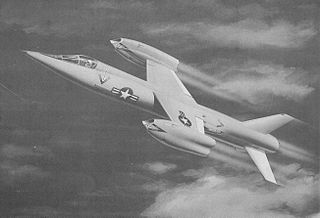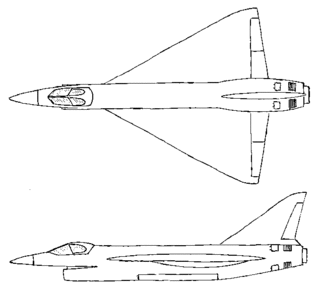
The McDonnell XF-88 Voodoo was a long-range, twinjet fighter aircraft with swept wings designed for the United States Air Force. Although it never entered production, its design was adapted for the subsequent supersonic F-101 Voodoo.

The Yakovlev Yak-38 was Soviet Naval Aviation's only operational VTOL strike fighter aircraft in addition to being its first operational carrier-based fixed-wing aircraft. It was developed specifically for, and served almost exclusively on, the Kiev-class aircraft carriers.

The Yakovlev Yak-141, also known as the Yak-41, is a Soviet supersonic vertical takeoff/landing (VTOL) fighter aircraft designed by Yakovlev. Intended as a replacement for the Yak-38, it was designed as a supersonic fleet defence fighter capable of STOVL/VTOL operating from Soviet carriers. Four prototypes were built before the project's cancellation.

The Republic XF-103 was an American project to develop a powerful missile-armed interceptor aircraft capable of destroying Soviet bombers while flying at speeds as high as Mach 3. Despite a prolonged development, it never progressed past the mockup stage.

The Bell D-188A was a proposed eight-engine Mach 2–capable vertical take-off and landing (VTOL) tiltjet fighter that never proceeded past the mock-up stage.

The Soko J-22 Orao is a Yugoslavian twin-engined, subsonic ground-attack and aerial reconnaissance aircraft. It was developed and built in collaboration by SOKO in Yugoslavia and by Avioane Craiova in neighbouring Romania, being known in the latter as the IAR-93 Vultur.

The Northrop XP-79, USAAF project number MX-365, was a rocket and jet-powered flying wing fighter aircraft, designed by Northrop. The pilot operated the aircraft in a prone position, permitting him to withstand much greater g-forces in pitch. It also used a welded magnesium monocoque structure instead of riveted aluminum.
The Grumman G-118 was a design for an all-weather missile-armed interceptor aircraft for use on US Navy aircraft carriers. Originally conceived as an uprated F11F Tiger, it soon evolved into a larger and more powerful project. Although two prototypes were ordered in 1955, development was cancelled the same year in favor of the F4H Phantom II before any examples were built. Grumman's next carrier fighter would be the F-14 Tomcat, ordered in 1968.

The Novi Avion was a fourth generation multi-role combat aircraft programme that was to be built by Yugoslav aircraft manufacturer SOKO.

The Rockwell XFV-12 was a prototype supersonic United States Navy fighter which was built in 1977. The XFV-12 design attempted to combine the Mach 2 speed and AIM-7 Sparrow armament of the McDonnell Douglas F-4 Phantom II in a VTOL fighter for the small Sea Control Ship which was under study at the time. On paper, it looked superior to the subsonic Hawker Siddeley Harrier attack fighter. However, it was unable to demonstrate an untethered vertical takeoff and its inability to meet performance requirements resulted in the program's termination.

Operational Requirement F.155 was a specification issued by the British Ministry of Supply on 15 January 1955 for an interceptor aircraft to defend the United Kingdom from Soviet high-flying nuclear-armed supersonic bombers.

The FMA SAIA 90 was a cancelled air superiority fighter aircraft project, designed by the FMA with the collaboration of Dornier in the mid-1980s. The SAIA 90 was the last stage of the ACA project, which was started by the National Reorganization Process to develop an Argentine fighter aircraft.

The Vought XF8U-3 Crusader III was an aircraft developed by Chance Vought as a successor to the successful Vought F-8 Crusader program and as a competitor to the McDonnell Douglas F-4 Phantom II. Though based in spirit on the F8U-1 and F8U-2, and sharing the older aircraft's designation in the old Navy system, the two aircraft shared few parts.

The Helwan HA-300 was a single-engine, delta-wing, light supersonic interceptor aircraft developed in Egypt during the 1960s.

The Saab 36 was a cancelled Swedish supersonic bomber planned by Saab AB during the 1950s. The aircraft was intended to be able to carry an 800 kg free-falling nuclear weapon, but the Swedish nuclear weapons program was cancelled in the 1960s; the plans for the bomber had been cancelled in 1957. The Saab 36 was to be fitted with delta wings, as was the Saab 35 Draken fighter. The engine was to be a version of the British Bristol Olympus turbojet, the same engine powering the Avro Vulcan jet bomber.
The Shenyang J-13 was a long-running Chinese project by Shenyang Aircraft Corporation to develop a light-weight, single engine fighter aircraft, which was ultimately cancelled.

The Yakovlev Yak-140 was a Soviet prototype lightweight supersonic fighter developed during the 1950s. The prototype was completed in 1954, but it was denied authorization to enter flight testing and the program was cancelled in 1956.
The IAR 13 is a Romanian low-wing monoplane fighter-trainer aircraft designed before World War II.

The IAR-111 Excelsior was a supersonic mothership project, designed by ARCA Space Corporation, intended to transport a rocket payload up to 18,000 m (59,000 ft) and for developing space tourism related technologies. The aircraft was supposed to be constructed almost entirely from composite materials, and was to be designed for take-off and landing from the sea surface.

The ALR Piranha was an aircraft project undertaken by the Swiss Air Force's Swiss Working Group for Aerospace (ALR) to develop a lightweight multi-role combat aircraft with canard wings. The ALR is the Aerospace Project Development Group of the Swiss Air Force. The project was managed by Bridel, an engineer at the ETH Zurich.

















